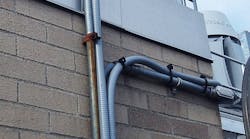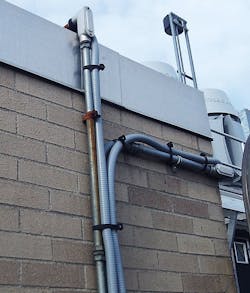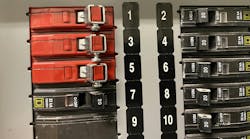Hint: Hitching a ride
Scroll Down to See Answer
The installer of this liquidtight flexible metal conduit (LFMC) should send a “Thank You” note to the electrician who installed the rigid metal conduit (RMC) for making his job easier. Unfortunately, the authority having jurisdiction (AHJ) might be sending a note to the LFMC installer explaining that his installation is a Code violation.
Generally speaking, Sec. 300.11(C) tells us that raceways should not be used for supporting other raceways, cables or other non-electrical equipment. Using LFMC for this installation could be considered a violation of Sec. 350.10 since the need for flexibility or protection from liquids is obviously not required here. The RMC installation proves that point. The installer apparently wanted to take the easy way out. Installing another RMC or perhaps EMT or even PVC conduit would have made for a better installation.
I’m also curious how many bends are in the run of LFMC. LFMC installations must comply with Sec. 350.26 and must not have more than 360° of bends between pull points. Since the LFMC is longer than 6 ft, Sec. 250.118(6) tells us it cannot be used as an equipment grounding conductor (EGC). Hopefully, the installer included an equipment grounding wire with the circuit wires, otherwise the equipment connected to the LFMC may not be grounded and bonded properly.





